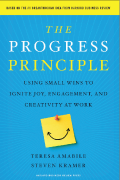TD Magazine Article
Recognizing Meaningful Progress
The Progress Principle: Using Small Wins to Ignite Joy, Engagement, and Creativity at Work by Teresa Amabile and Steven Kramer. Passion and Purpose: Stories from the Best and Brightest Young Business Leaders by John Coleman, Daniel Gulati, and W.
Thu Mar 01 2012
Bookmark
The Progress Principle: Using Small Wins to Ignite Joy, Engagement, and Creativity at Work

By Teresa Amabile and Steven Kramer
(Harvard Business Review Press, 272 pp., $25)
The key to employee engagement, say authors Teresa Amabile and Steven Kramer, is ensuring that employees have a good inner work life—“the conditions that foster positive emotions, strong internal motivation, and favorable perceptions of colleagues and the work itself.”
The Progress Principle gives managers a peek into those inner work lives via daily diary entries from more than 200 professionals who describe what they really think and feel about day-to-day work events and how those events affect their performance, motivation, and engagement.
Amabile and Kramer collected some 12,000 diary entries from 238 professionals from 26 project teams in seven companies about major daily work events and the state of their daily inner work lives. Of all the factors that made for a good inner work life, making progress toward meaningful work was found to be the strongest.
In one example, after 30 project managers of a firm had been laid off, one bitter employee made plans to spend vacation time with her family. But during her time off, the company requested her help for a crucial project. Her participation eventually led to one of her highest states of “inner work life.” Her entry on her second day on the crucial project:
“More work today on the big DreamSuite lawsuit problem. The boss’s boss came by to offer encouragement. That was nice. He bought us bottled water! Not the cheap stuff I buy either. … Nobody’s snapped yet, though, I have to admit that I love working under pressure.”
The good news, say the authors, is that when managers acknowledge and support daily progress with “catalysts” (actions that facilitate progress) and “nourishers,” (interpersonal encouragement), they help to create the “progress loop, the self-reinforcing process in which progress and inner work life fuel each other.”
However, the flipside is true as well; the research showed how management’s influence also can be strong and negative, in the case of unclear goals and setbacks—conditions that block progress and demoralize employees on a daily basis.
The authors also include a comprehensive checklist to help managers develop the right mindset and implement a system for recognizing progress on a daily basis.
Three cups!
Passion and Purpose: Stories from the Best and Brightest Young Business Leaders
John Coleman, Daniel Gulati, and W. Oliver Segovia

(Harvard Business Review Press, 320 pp., $25.95)
The authors share how the upcoming generation is changing business interactions and redefining leadership roles. Far from accounts of the stereotypical generation of entitled slackers, the stories in Passion and Purpose demonstrate the innovation, collaboration, efficiency, and independence of rising young leaders. Drawing on a survey of 500 students from top U.S. business schools, the authors found six core themes to be prominent in the lives of today’s young business leaders: convergence, globalization, people, sustainability, technology, and learning. The authors divide the book into six chapters, describing how each of these themes developed during their research.
The e-HR Advantage: The Complete Handbook for Technology-Enabled Human Resources
Deborah Waddill and Michael Marquardt

(Nicholas Brealey Publishing, 288 pp., $49.95)
This book offers an introduction to technologies designed to aid those working in human resource development or management. The authors use their combined backgrounds in strategic planning and organizational learning to deliver a practical handbook detailing many of the options available for HR departments interested in the latest technological developments. The book is divided into five sections, covering topics such as learning systems, technologies for managing human resources, communication technologies, and knowledge management. Each chapter contains a mixture of case studies, tables, and explanations of what each technology is and how it can be used to best serve the needs of HR professionals.
The Perfect Hire:A Tactical Guide to Hiring, Developing, and Retaining Top Sales Talent Katherine Graham-Leviss

(Entrepreneur Press, 204 pp., $19.95)
German philosopher Friedrich Nietzsche once said: "No victor believes in chance." The process of hiring can be frustrating, especially when a candidate with the appropriate background, experience, and job skills turns out to be a poor fit post-hire. Graham-Leviss aims to help employers to select candidates who are not only qualified, but also a good match with the organization. Moving beyond the initial hiring process to discuss onboarding and development strategies, Graham-Leviss describes how to develop your sales talent, find and fix the gaps in your sales team, and use data and benchmarks to develop and manage your employees.
What’s on Ken Blanchard’s Bookshelf?
I’m a big fan of Patrick Lencioni. The 5 Dysfunctions of the Team is one of my favorite books because I’m a big believer in parables and shorts, and Lencioni teaches “simple truths.”
Another book on my desk is Jim Collins’s From Good to Great. He focuses on resolve and determination to accomplish a goal according to vision, as well as humility. It’s consistent with servant leadership, which I’m a great fan of. That’s when you have to philosophically turn the pyramid upside down, and you work for the people.

Max DePree, the legendary chairman of Herman Miller, wrote Leadership Is an Art—that’s a book I would recommend to people. I once asked him, “Max, what’s your job as the chairman of this great company?” And he said, “I’m like a teacher; I have to say the vision and values over and over and over again until people get it right.”
More from ATD
